Full arch implant restorations involve a wide spectrum of costs, and for procurement teams and dental practices, understanding the true cost drivers is critical to making informed choices. Pricing is shaped by multiple dimensions: materials, case complexity, digital workflow integration, logistics, quality assurance, and commercial terms. Evaluating these elements allows decision-makers to see beyond headline quotes and recognize long-term value in their partnerships with dental laboratories.
From a procurement perspective, several drivers consistently impact cost structures:
- Materials and prosthetic design — titanium vs. zirconia, premium vs. standard components.
- Implant numbers and surgical complexity — additional procedures such as bone grafts or sinus lifts.
- Digital workflow investment — CAD/CAM, 3D printing, and file management efficiency.
- Logistics and geography — international shipping, customs, and turnaround requirements.
- Quality assurance and remake policies — balancing upfront expense with risk mitigation.
- Commercial factors — bulk vs. single orders, OEM/ODM partnerships, and regional economics.
By weighing these factors together, procurement leaders build a structured framework for supplier evaluation and cost control. The most reliable outcomes come not from chasing the lowest quote, but from assessing how each factor influences quality, turnaround time, and sustainability. This transforms the cost discussion from a short-term transaction into a strategic procurement decision, enabling dental practices to secure both efficiency and long-term value in their lab collaborations.
How Does the Number of Implants and Case Complexity Affect Pricing?
Full arch restorations cost significantly more than single-unit cases because the number of implants, surgical steps, and technician hours all scale together. More implants mean more abutments, frameworks, and occlusion checks, which directly raise the lab bill. The complexity of these cases also requires closer collaboration between the clinic and the lab to minimize costly remakes, a factor that many buyers underestimate until they see the final invoice.
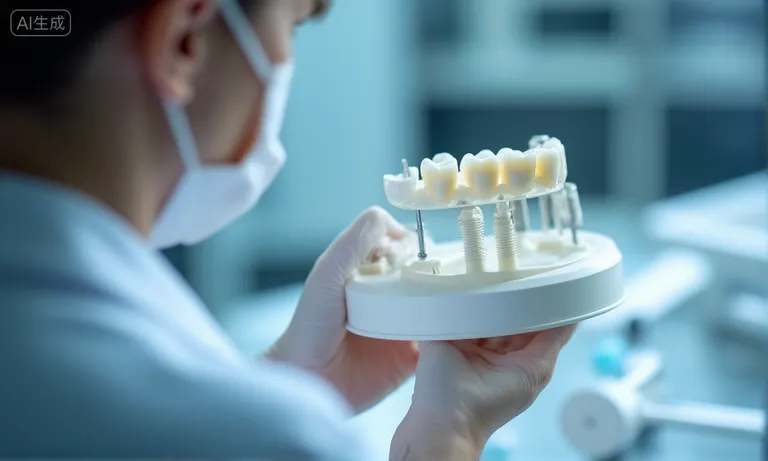
Full-arch-implant-case-lab-cost
Why are full arch restorations more costly than single units?
Full arch implant cases are more costly because they require several implants to support the prosthesis. Each implant adds to the total material requirement, abutment cost, and framework size. Compared to a single crown, a full arch demands exponentially more scanning, design, and quality checks. The laboratory must allocate additional resources to verify occlusion and ensure fit across multiple implants, which drives up technician hours and overhead.
How do additional procedures like bone grafting or sinus lifts add cost?
While these procedures are performed chairside, their impact extends to the lab. Bone grafting or sinus lifts often change the angulation or available height for implants. That means the lab must adapt the design, use angled abutments, or mill custom frameworks. Each adaptation increases production time and requires additional CAD/CAM runs. Even though the lab is not directly billing for the surgery, the complexity of the supporting prosthesis reflects those surgical choices.
What role does occlusion checks and technician hours play in pricing?
For multi-implant restorations, every occlusal contact must be checked across the arch. A small discrepancy can cascade into costly remakes if it affects patient comfort. Labs allocate more technician hours to fine-tune bite alignment, especially for full arch bridges. This extra attention is part of why full arch cases can be priced several times higher than single-unit crowns. As an overseas dental lab, Raytops Dental Lab often collaborates with clinics to standardize check protocols, reducing adjustment time and avoiding unnecessary remakes.
When clinics understand how implant count and case complexity affect cost, procurement discussions become clearer. Instead of seeing the bill as arbitrary, they can trace the expense back to specific technical demands, which builds trust and smoother cooperation.
How Do Materials and Prosthetic Design Affect Dental Lab Costs?
Materials and design decisions are among the most decisive cost drivers for full arch restorations. Choosing between titanium, zirconia, and porcelain-fused-to-metal (PFM) changes not only the unit price but also the durability and long-term value of the case. On top of that, complex prosthetic designs require more technician hours, advanced CAD/CAM work, and precise finishing steps. Balancing premium and standard options is not just a financial choice—it’s a strategy for long-term treatment success.
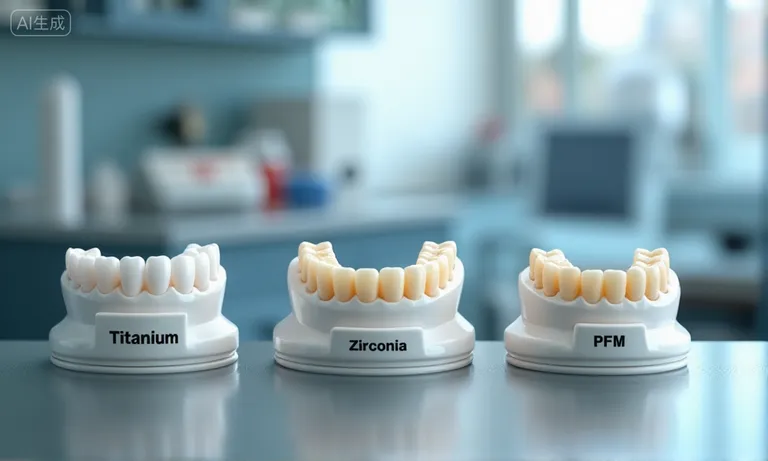
Dental-lab-materials-cost-comparison
How do titanium, zirconia, and PFM compare in price and durability?
| Material | Relative Cost | Durability | Common Use Cases |
|---|---|---|---|
| Titanium | Moderate | Very high (strong frameworks, biocompatible) | Substructures, long-span frameworks |
| Zirconia | Higher | High (aesthetic, strong under occlusion) | Full-contour bridges, esthetic zones |
| PFM | Lower | Moderate (risk of chipping over time) | Budget-sensitive cases, posterior restorations |
Titanium offers exceptional strength and long-term reliability, but aesthetics are limited. Zirconia provides a balance of durability and esthetics, though costs more upfront. PFM remains economical, but chipping risk and shorter lifespan often increase long-term expense. For procurement managers, understanding these trade-offs is key to aligning budget with patient outcomes.
Why does prosthetic design complexity increase lab fees?
Design complexity drives higher fees because it demands more intricate CAD/CAM modeling and manual finishing. Multi-layered zirconia arches, angled screw channels, or hybrid designs require longer milling times, more material waste, and additional technician oversight. Each design variable adds checkpoints for margin fit, occlusion, and framework stability. From the lab side, complex cases also have a higher remake risk, so extra QA steps are built into the fee structure.
When should premium vs. standard materials be considered for cost balance?
- Premium (zirconia, advanced titanium frameworks): When longevity, esthetics, and reduced remake risk outweigh initial savings. Ideal for full arch bridges in esthetic zones.
- Standard (PFM, base alloys): When budget control is a priority or for provisional restorations. Lower upfront cost, but higher long-term maintenance.
- Balanced approach: Many clinics mix premium and standard—using zirconia for anterior and PFM for posterior—to control total expense while maintaining visible quality.
As a global dental lab, Raytops Dental Lab frequently supports clinics in choosing the right balance, offering cost comparisons and advising on design feasibility.
When clinics evaluate materials and design through both cost and durability lenses, procurement moves from a short-term decision into a long-term investment in patient satisfaction and fewer remakes.
How Does Digital Workflow Influence Laboratory Fees?
Digital workflows add both savings and expenses to dental lab operations. CAD/CAM systems, 3D printing, and software integrations reduce remake rates and improve precision, but they also require higher upfront investment in equipment, licenses, and technician training. For procurement managers, the key is to understand where digital tools cut hidden costs, and where they create new line items on the invoice.
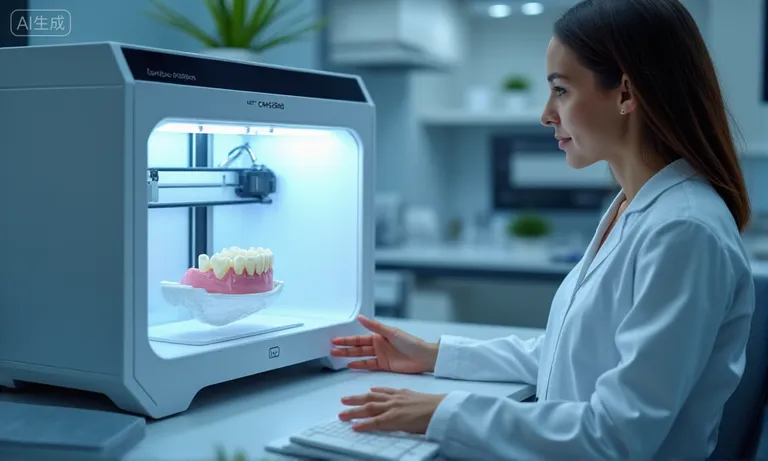
Dental-lab-digital-workflow-cost
What costs are associated with CAD/CAM, 3D printing, and software?
- CAD/CAM systems: Milling machines and scanners require large initial investments, plus ongoing calibration and maintenance.
- 3D printing: Resin, powder, or hybrid printers lower material waste but carry consumable costs for cartridges, resins, and frequent part replacements.
- Software licenses: CAD design platforms and digital libraries charge recurring fees, which labs include in their pricing structures.
For clinics, these costs often translate into slightly higher per-unit prices, but the benefit is more consistent accuracy across cases.
How does file compatibility or margin design complexity change cost?
Digital workflows are only efficient when files are compatible. STL, PLY, and intraoral scan formats sometimes require conversion or clean-up, adding technician time. Complex margin designs, such as deep subgingival finishes, challenge software recognition and often need manual correction. This extra labor increases fees because it negates some of the automation savings. Overseas labs with broad software integration can reduce these bottlenecks by standardizing file intake protocols with their partners.
Why can digital adoption lower remake rates but raise upfront expenses?
- Lower remake rates: Digital scanning and milling minimize human error, reducing adjustments and chairside time.
- Higher upfront expenses: Labs bear the cost of equipment, software subscriptions, and technician training before efficiencies are realized.
- Long-term value: Once integrated, digital workflows stabilize production quality, resulting in fewer remakes and faster turnaround.
For many clinics, the math balances out: paying slightly more per unit can actually save money over the year by lowering remake-related delays. As an overseas dental lab, Raytops Dental Lab has seen clinics cut remake incidents by up to 20% after switching to fully digital collaboration.
When procurement teams view digital workflows as a risk-control mechanism rather than a pure expense, they can see how the higher upfront lab fees serve as insurance against costly remakes and long treatment cycles.
What Logistics and Regional Differences Add to Overall Expense?
Beyond materials and design, logistics and regional factors often make the biggest difference in total lab fees. International shipping, customs duties, and time-zone coordination all add hidden costs. At the same time, location-based price gaps between overseas and local dental labs can reshape a procurement budget. Understanding these elements helps clinics set realistic expectations and compare quotes more accurately.
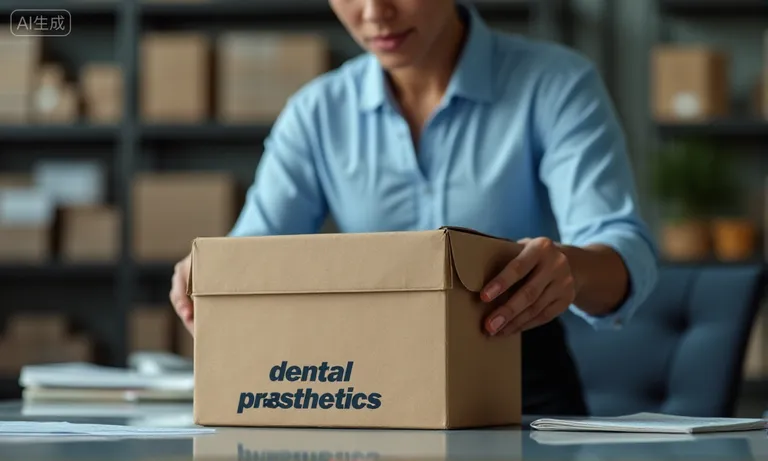
Dental-lab-international-shipping-cost
How does international shipping and customs affect lab pricing?
Shipping fees vary by distance, speed, and carrier. For international dental labs, customs duties and brokerage charges can add up quickly. Temperature-controlled packaging and secure handling requirements for delicate prosthetics also increase expense. Labs that manage consolidated shipments often achieve better unit costs, while smaller, urgent packages drive fees higher. These logistics variables are usually itemized in lab invoices and can represent a significant share of the final cost for overseas clients.
Why do turnaround time pressures increase logistics costs?
- Express courier fees: Faster delivery means paying premium rates to carriers.
- Priority handling: Urgent cases may require labs to reschedule technicians or extend working hours, adding labor cost.
- Increased remake risk: Compressed timelines reduce margin for error, sometimes resulting in higher remake incidence and wasted shipping expense.
For clinics, planning cases with realistic timelines is one of the easiest ways to reduce total procurement spend.
How do costs differ between China-based labs and local providers?
| Factor | China-Based Labs | Local Providers |
|---|---|---|
| Base Lab Fee | Lower (economies of scale, lower overhead) | Higher (local wages, smaller production scale) |
| Shipping & Customs | Higher (international courier, duties) | Minimal or none |
| Turnaround Time | Longer (shipping days added) | Faster (same-region delivery) |
| Cost Predictability | Moderate (currency exchange + customs variability) | High (stable local logistics) |
Many procurement managers weigh whether the lower base fee from a Chinese dental lab offsets the extra shipping costs. For high-volume cases, the savings usually remain significant. As a global dental lab, Raytops Dental Lab has supported clinics in balancing these trade-offs by offering bulk shipping schedules and transparent customs handling.
Ultimately, the regional equation is not just about price. It’s about predictability, shipping reliability, and aligning the lab’s logistics strategy with the clinic’s treatment schedule.
How Do Quality Assurance and Remake Policies Impact Cost Control?
For procurement teams, quality assurance and remake terms are not just fine print—they are critical levers for controlling long-term costs. High remake rates can erode savings from lower lab fees, while strong QA systems and clear warranty terms reduce risk and stabilize budgets. Understanding how labs handle these issues is essential for choosing reliable partners.
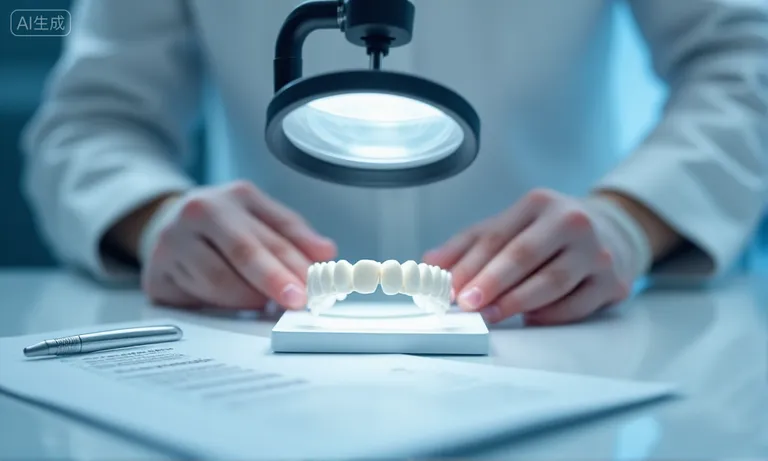
Dental-lab-quality-assurance-check
What is the hidden cost of high remake rates for full arch cases?
Remakes are one of the most expensive hidden costs in full arch cases. Even a single failure means new materials, technician hours, and often additional shipping. Chairside time also increases, which indirectly adds cost to the clinic. A lab with a remake rate above 8–10% can quickly negate any upfront savings, making “cheap quotes” more expensive in the long run. For complex full arch bridges, every percentage point reduction in remakes translates into measurable savings for procurement managers.
How do strict QA and ISO/FDA compliance increase upfront cost but reduce risk?
- Higher upfront cost: Labs that follow ISO 13485 or FDA-compliant workflows invest in calibrated equipment, batch traceability, and multi-step inspections. These processes add technician hours and audit costs to each case.
- Lower long-term risk: These same standards ensure consistent fit and material authenticity, reducing remakes, complaints, and liability exposure.
- Procurement value: Clinics benefit from predictable outcomes, especially when treating high-value implant cases where a single remake could delay patient treatment for weeks.
Why do warranty and remake terms matter for procurement decisions?
| Policy Factor | Impact on Clinic | Impact on Lab |
|---|---|---|
| Clear remake policy | Provides cost predictability for buyers | Aligns expectations and reduces disputes |
| Warranty coverage | Extends protection for defects, lowers replacement cost | Builds trust but requires strict QA |
| Flexible timelines | Supports clinics handling long treatment cycles | Requires labs to manage inventory and logistics |
Warranty and remake agreements create a foundation of trust. Clinics that know their lab will stand behind its work are more willing to commit to long-term procurement. As an overseas dental lab, Raytops Dental Lab has found that transparent remake policies help clinics in North America and Europe plan budgets with greater confidence, even when working across borders.
Quality assurance and remake terms should never be an afterthought. They determine whether lower upfront prices truly translate into sustainable savings.
What Procurement Factors Shape Final Dental Lab Quotes?
Final quotes from dental labs are shaped not only by technical factors but also by commercial terms. Procurement managers need to consider volume discounts, partnership models, and even currency fluctuations when negotiating. These elements can turn a one-time purchase into a scalable, predictable supply chain investment.
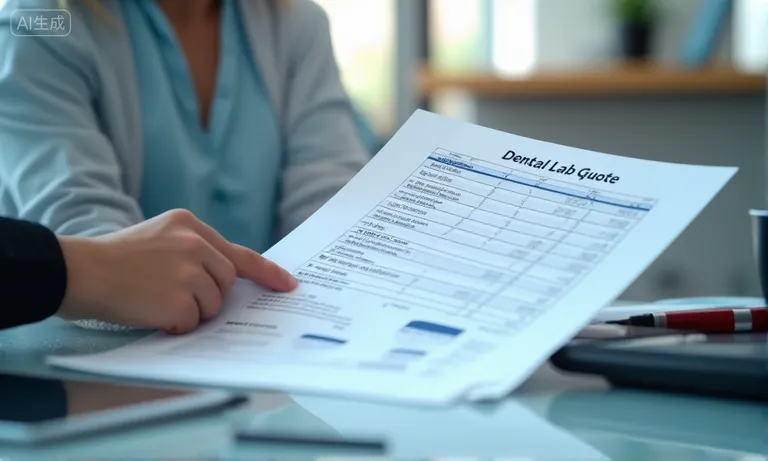
Dental-lab-procurement-quote-factors
How do bulk orders vs. single cases change unit pricing?
- Single cases: Higher unit cost due to setup time and limited economies of scale.
- Bulk orders: Lower per-unit cost as labs consolidate production, materials, and shipping.
- Practical takeaway: Clinics that pool orders across multiple locations often achieve better long-term pricing and more consistent turnaround times.
Why does OEM/ODM partnership reduce long-term procurement cost?
Partnership models such as OEM (original equipment manufacturing) or ODM (original design manufacturing) create deeper integration between clinics and labs. By standardizing workflows, co-developing prosthetic lines, and aligning digital systems, both sides reduce redundancies. While initial setup may require investment, these partnerships often lower design costs, simplify logistics, and improve product consistency. For procurement teams, this model transforms the lab from a supplier into a strategic cost-control partner.
What role do exchange rates and regional economics play in pricing?
| Factor | Impact on Overseas Labs | Impact on Buyers |
|---|---|---|
| Exchange rates | Fluctuations affect quotes in USD/EUR vs. RMB | Procurement teams face variable costs month to month |
| Regional labor cost | Lower wages in Asia reduce base fees | Buyers gain cost advantage if logistics remain efficient |
| Economic stability | Inflation and policy shifts can alter raw material pricing | Budget predictability may vary depending on supplier region |
For buyers working with a Chinese dental lab, monitoring exchange rates is just as important as checking material costs. Transparent quotes that factor in regional economics provide stability in long-term agreements. As a global dental lab, Raytops Dental Lab supports clinics by offering fixed-term pricing models that reduce exposure to currency volatility.
When procurement teams weigh commercial terms alongside technical specifications, they gain a more accurate picture of the “true cost” of collaboration. This makes the difference between chasing low quotes and building sustainable partnerships.
Conclusion
The cost of full arch implant restorations is shaped by many factors—materials, case complexity, digital workflows, logistics, quality assurance, and procurement terms. For clinics and procurement managers, the real challenge is not just comparing quotes but understanding the trade-offs behind them. Choosing the right partner can transform cost from a fluctuating burden into a predictable investment in patient satisfaction and long-term stability. As an overseas dental lab, Raytops Dental Lab collaborates with clinics worldwide to balance affordability, reliability, and technical precision. When procurement teams align with a lab that combines structured QA, digital integration, and transparent pricing, they gain more than a supplier—they secure a partner in sustainable growth.


